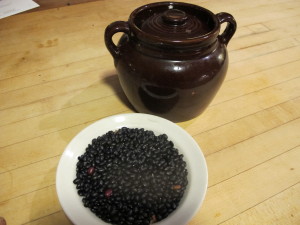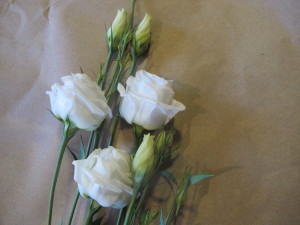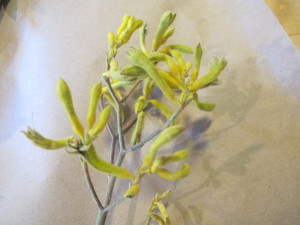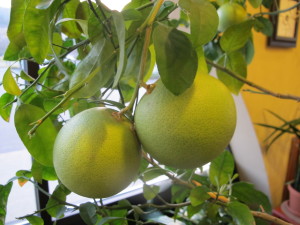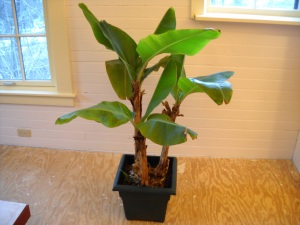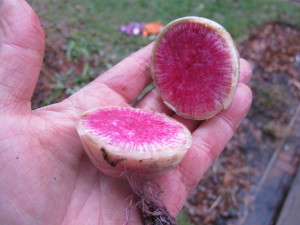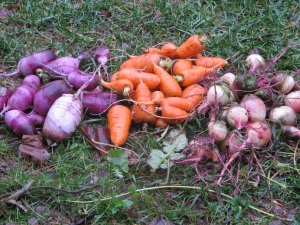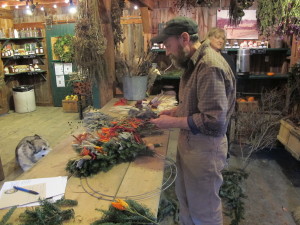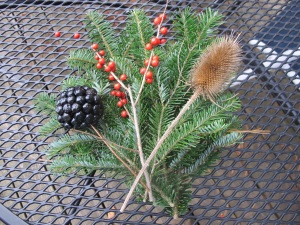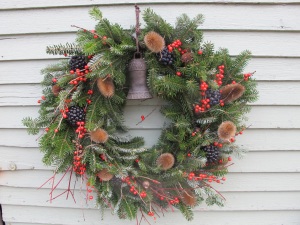Eating My Own Veggies
A dozen years ago I decided to become rich and famous by writing a bestselling book. I would travel the country, talking to farmers – some conventional, some organic, some using that “new” technology of the time, GMO agriculture. I thought my book would explain what eaters wanted to know about how their food was produced. It would outsell Fast Food Nation.
I outfitted my aging van with a bed, a fridge and a small battery-operated fan for those days when the temperatures exceeded 100 degrees (the van had no AC). I drove across the country, talking to farmers along the way. I had made arrangements to work on a 300 acre organic farm in Idaho for a few weeks, working alongside the Peruvian laborers. Unfortunately, I never found a publisher for the idea, so I never wrote the book. But I learned a lot about commercial agriculture.
In Idaho, I remember bouncing along on the back of a 4-wheeler to see a conventional potato farmer’s fields. He stopped and added 4 ounces of fungicide into an irrigation pivot that served 30 acres of potatoes. What would happen if one of his laborers, many of whom do not read English, had added a quart of fungicide instead of 4 ounces? And why, I wondered, did the farmer have a garden where his wife grew veggies for their use, including potatoes? That reinforced my conviction that I want to eat organic food, preferably food I grow myself.
This past summer I had access to a large field that been tended organically for years, but allowed to go fallow. I grew potatoes, tomatoes, squashes of all sorts, corn, beans and more. I called it my farmette.
In the past I had only grown beans for fresh eating or for freezing. But with plenty of space, I also grew beans for drying despite the fact that dry beans are not expensive – at least not the conventional ones. Still, I thought, wouldn’t it be nice to make baked beans or chili just using my own dry beans?
Dry beans are a lot of work – beyond just planting, weeding and protecting from the deer (who love them). The bean pods must get totally dry either in the field or in the barn or house. In good weather, letting them dry on the vine is best. Then they must be threshed or hulled. That means getting every last seed out of the shells, which can be tedious. And it is hard to get all the bits of the outer hulls separated from the beans. Winnowing outdoors on a windy day is the easiest way to do so. Fortunately my partner, Cindy, finds getting dry beans ready for winter use to be a nice contemplative task.
Invited to a solstice potluck, I decided to make a pot of baked beans just using my own ingredients – or as close to it as possible. The beans were a big success, so I’m sharing the recipe with you. And, obviously, you can buy the beans or anything else you lack from your own garden.
½ lb. bacon, chopped (optional)
2 cups dry black beans, soaked overnight in plenty of water
3-4 cups chopped tomatoes – frozen whole, or from a can
2 large onions, chopped medium to fine.
2 cloves, minced
2 cups dried pears or other dried fruit (apricots work well, too, but use less)
1 to 2 cups dried cherry tomatoes
3-4 ounces tomato paste
1 teaspoon dry mustard
1 tablespoon Herbes de Provence (or rosemary and thyme)
Dried hot pepper to taste – ½ teaspoon of chipotle is a good start. Jalapenos or Espellette are good, too.
½ cup maple syrup or more, to taste
Salt and pepper to taste
Water as needed.
I began by rinsing the beans that had soaked overnight, and cooking them for an hour with plenty of water. They soak up considerable water.
In a heavy enameled pot I fried the bacon, then drained most of the fat. I used a local thick-cut smoked bacon, Garfield’s, from Meriden, NH – just down the road from me. Then I added the onions, and cooked at low heat until translucent. If making vegetarian beans, use olive oil to sauté the onions.
To the onions and bacon I added the beans and immediately covered with water. I added the chopped tomatoes that I had frozen whole last summer, the tomato paste, the maple syrup, spices and garlic, and continued cooking at low heat. The beans should be covered with liquid at all times.
Dried pears or other fruit add a nice sweetness to the beans, but you can add more maple syrup instead. I chopped my pears into small pieces, and added them with the dried cherry tomatoes to the pot.
I cooked the beans on the stove top for an hour, tasting often to see if I needed more hot peppers, other spices or maple syrup. Then I transferred everything into a ceramic bean pot and put it in the oven, covered, for another 2 to 3 hours at 300 degrees. Watch out for juices bubbling over – I always keep a cookie sheet under the pot. Add water if the beans get too dry.
For me, at least, eating something wonderful created from my own veggies and fruits is a real treat. I know that it has no toxic chemicals and that the ingredients have been grown with love. So start planning your vegetable garden now – the days are already getting longer.
Henry is the author of 5 books. His website is www.Gardening-guy.com.
Buying Cut Flowers
Technically, winter is here – despite the lack of snow. The sun is often lurking behind gray clouds, and on a good day we get just 9 hours of light. I miss the colors of summer. I still try to keep fresh cut flowers on the table – even if they’re not flowers from my garden.
Cut flowers are among modern America’s true bargains. For the price of a bottle of wine – or even a few of cups of fancy coffee – you can buy flowers that will grace your table for up to three weeks. But there are some things you should know about getting good table-life for your investment.
First, you need to buy fresh flowers that have been carefully tended – and you can’t beat a florist for that. Yes, grocery stores sell bouquets, but many grocery stores sell bouquets in the fruit and vegetable department. Apples and some other fruits give off ethylene gas, which promotes ripening – or in the case of flowers, getting old and unattractive.
Cut flowers need to take up water to stay fresh and healthy. Stems tend to scab over after a day or two, which means they cannot take up replacement water, or not much, so they suffer. A floral shop has trained personnel who trim each stem in the store every other day, taking off three quarters of an inch each time. And someone who regularly changes the water to keep to keep it fresh. Chain grocery stores probably count on you buying their flowers before the flowers need to be trimmed or their water changed.
When you bring your flowers home, get them right in water. And follow the 3-second rule: never take longer than 3 seconds to get your flowers in the vase after trimming the stems. Most florists give you packs of powder to put in the water, and the stuff works to keep flowers fresh longer. It inhibits bacteria from growing, which is good. Bacteria will impede water take-up.
If you want maximum life out of you flowers, NEVER let leaves enter the water. Leaves will rot, promoting growth of bacteria. And keep your arrangement cool if you can. Putting it near a radiator or woodstove will shorten its life. If you have invested in roses or tulips, you may wish to move the vase to the entryway or mudroom at bedtime to keep the flowers extra cool during the night – or put them in the fridge.
Some flowers are better picks than others if you’re on a budget and can’t afford to buy new flowers every week. Here are my recommendations for good cut flowers:
- Lisianthus: These look like silk flowers to me: perfect white, pink or lavender-colored bell-shaped flowers on long stems. Tough to grow in the garden, they are perfect in a vase – I’ve kept them for up to 3 weeks.
- Miniature carnations: Each stem has 2 to 4 blossoms. They come in a variety of colors. Mix dark red “minis” with red roses to make a bouquet of roses look fuller. And even after the roses go to
Valhalla, the carnations will still be good!
- Chrysanthemums: These come in a variety of sizes and colors, from the huge spider mums to little guys. I love the scent of the flowers –it’s not overpowering, but it’s there if you sniff them.
- Statice. I grow these for use as dry flowers, which tells you that they really do last forever – even out of water. They come in blue, purple, pink and white.
- Spray roses: Instead of a single blossom per stem, these have 2-5 blossoms, giving you more bang for your buck. Will last about a week with proper care
- Alstromeria: Each long stem has clusters of 2-inch lily-like blossoms in pinks and reds, with yellow throats. Very long-lived. Great value.
- Kangaroo paws: These Australian natives are fuzzy and cute. They come in pinks, reds and browns, and last very well. Not every florist will have them, but ask.
Looking for a fun project with your kids? It’s easy to change the colors of chrysanthemums. Leave them out of water for 12 hours, then cut off 2-3 inches and put them in water with food coloring. Obviously, you should start with white chrysanthemums. The colors you get may not be exactly the color you see on the food coloring, but it can be quite dramatic.
Everyone loves to receive the gift of cut flowers, even guys. So treat your loved one – or yourself- to fresh flowers this winter. They’re cheerful, and can make winter less oppressive.
Henry is the author of 4 gardening books, including a new, revised second edition of The New Hampshire Gardener’s Companion: An Insider’s Guide to Gardening in the Granite State. His website is www.Gardening-guy.com.
Growing Fruit Indoors
When I was a boy of eight or nine I planted a grapefruit seed, hoping it would produce a tree that would provide us with a nice source of winter fruit. Ten years later it was 3 to 4 feet tall, with nice shiny leaves. I went off to college, leaving it in the care of my houseplant-challenged mom. Unfortunately, it pined for me and died a slow death – probably due to overwatering.
My grapefruit tree never blossomed in the 10 years I cared for it. So I was amazed to encounter a grapefruit tree loaded with fruit in the south-facing windows of my optometrist, Dr. Chris Fields in Lebanon, NH. He told me that he had planted seeds 22 years ago when his son was born, and that this was its second year of producing fruit.
Dr. Fields said it bloomed magnificently this past spring and that he went around with a paint brush, transferring pollen from stamens to pistils. The year before he had allowed moving air to do the pollinating, and he had fewer fruits. Some of his fruit felt heavy and full of moisture, others felt light – as if they were made of green Styrofoam. Huh. He’s not sure if they will fill up later.
Meanwhile, I am experimenting with my pineapple plant. I reported in this column last summer that I had bought a pineapple plant, even though I was told that after harvesting its one fruit, the plant would die. I ate the fruit in July and kept it going all summer, enjoying the large, shiny strap-like leaves.
Each fall I pick the “team” of plants that get to come inside for the winter, and competition for window space is tough. The pineapple did not make the team this fall, and after a few hard frosts I went to clean out the pot for winter storage. Much to my surprise, there were two new green shoots growing beneath the frosted leaves, and the root system appeared vigorous.
So I cut off all the old, dead leaves and re-potted the youngsters and brought them in. We shall see what happens, but my mouth is watering as I think about the fresh pineapples I (may) get next summer, or perhaps the summer after. It’s always fun to experiment.
Back when I was a kid a common school project was to start an avocado plant by suspending a pit by three toothpicks in a glass of water, allowing the base to just kiss the water. But when I tried that a few years ago, I was unable to get one growing. I asked Mrs. Google, and she explained why: avocados need to be started soon after picking. And with modern refrigeration techniques, avocados can be kept edible for months – but older fruits will not start new plants from their pits. Makes sense.
In the fall of 2013 I spotted an avocado plant growing in the compost pile and rescued it, potting it up and giving it a place for the winter. These last two summers it has lived on the deck, getting sun and rain and generally enjoying life outdoors. It is now 30 inches tall, and the stem is half an inch in diameter. Of course I remember avocado trees from my time in the Peace Corps in West Africa – they were bigger than full-sized apple trees here when they were loaded with fruit, so I doubt that mine will ever be anything but a handsome houseplant.
I bought a small banana plant a dozen years or more ago, and kept it outdoors on my deck each summer, bringing it in for the winter ever since. It came with the variety name ‘Cavendish’ which is what most commercial bananas are.
In a 12-inch pot the banana plant got about 3 feet tall, but never taller. And it never hinted at producing fruit – though it did create several other small banana plants that could be dug and re-potted. This year I gave it to Dr. Fields – if he can get a grapefruit tree to produce, maybe he’ll get the bananas to produce, too. I told him that I want one of the bananas if it produces, though.
So Santa Claus, if you are reading this, here is my wish: I want a lemon or lime tree that will produce fruit for me here in Cornish Flat, New Hampshire. Yes, I know, Santa, that I have apples, plums and pears that produce nice fruit outdoors. But that is not the same. I want fresh citrus in winter, and know a number of people who have succeeded in growing lemons or limes indoors. And I’ve been a good boy this year … mostly.
Henry is a gardener who will try growing almost anything once. His email address is henry.homeyer@comcast.net. Let him know if you ever got a banana tree to produce. His mailing address is POB 364, Cornish Flat, NH 03746. He is the author or 4 gardening books.
Working in the Rain
After a cold snap recently we had 3 days of cold rain. By the second day, with no relief in sight, I went out to my garden and dug up the last of my root crops – carrots, watermelon radishes and purple daikon radishes. I figured that I’d better get them out of the ground while the getting was good. I came back wet and muddy, but feeling much more cheerful than before I went to the garden.
By day three, I was positively squirrely. I needed to do something outdoors. So I got dressed for an extended time in the garden: I layered on some Ibex brand wool long johns, two layers on top, and one on the bottom. Ibex makes its products from Merino wool, so they are not scratchy and seem to last forever. Then I put on rain pants and an LL Bean Gortex raincoat that keeps me dry and helps keep me warm. Rubber-palmed stretchy garden gloves protected my hands. Finally, I put on wool socks and my insulated Muck brand boots. I was ready.
I often warn gardeners not to walk on the garden soil when it is wet for fear of compacting it and ruining its structure. But I had some raised beds in the vegetable garden where I had harvested root crops – but not the late-season weeds that were there. I figured that so long as I worked carefully and never stepped off the walkways that I’d be fine.
I used a garden fork to loosen the soil near tap-rooted dandelions, then carefully tugged them out. How had so many escaped my notice? Well, I guess it was the “late-season weed blindness” that many of us suffer from. It is often spring before I notice certain weeds – because they’re blooming.
I did know, however, that I had a fair amount of chickweed (Stellaria media) in my garden, as that weed grows whenever the ground is not frozen – including early and late in the growing year. I once interviewed author David Mas Masumoto (author of Epitaph for a Peach) who told me that chickweed is a ”good weed”. It’s good because it blooms early and beneficial insects like ladybugs depend on its nectar for food before the aphids turn up as lunch.
Chickweed is a low-growing annual that has very small pointed leaves, each only a quarter to half an inch in length. The flowers – and mine are present now – are small and white; on cold rainy days, the flowers are just like me – buttoned up tightly. With a hand lense or field scope you can see that it has fine hairs on only one side of the stem in a single band. It pulls easily, and best of all, it is edible in salads! I think it tastes like mache or miner’s lettuce – okay to mix in, but not as a prime salad ingredient.
After about 15 minutes my hands were cold, so I went in and found my Ibex glove liners, which solved the problem. Wool is warm, even if wet. And I put on another layer of socks, and that kept my feet warm, too.
I buy composted cow manure by the truckload, and still have a supply left from last spring’s delivery. So after weeding out two small beds I brought down a couple of wheelbarrows of compost, spread it on top of the beds and gently stirred it into the top few inches with a long-handled potato fork.
I grow my vegetables in beds that are mounded up, or occasionally boxed in with planks. In either case, plants take out soil ingredients, and every time you pull a weed (or carrot) some soil goes with the roots, no matter how careful you are. So beds need new soil or compost added each year to keep their size.
Once the beds were all prepared for spring, I found some lawn that had been covered with late-falling leaves – oaks. Oaks are among the last to shed their leaves, and so had escaped earlier raking. I gathered them up and used them to cover the beds.
During this period of cold, cloudy, dark, damp, dismal miserable weather I collected some greenery to use in vases this winter. Pachysandra is a common shade groundcover that will look good all winter in a vase of water. In fact, it will even set out roots into the water. Just keep the leaves out of the water, and change the water from time to time. It doesn’t need to be on a sunny window, and can complement any flower arrangement you buy at the store. So I picked some and brought it in.
What else did I do during the week of wet weather? I did a little pruning – nothing major, no ladders, I just tuned up a few shrubs and a small tree. I have a common ninebark, one called ‘Diablo’, which looks as neat as an unmade bed right now. But I resisted the urge to prune it as I know it blooms early in the summer, and pruning it now would remove the flower buds. Lilacs, forsythia, and rhododendrons: all these and more have their buds ready for spring. Some flowers I can sacrifice, others not.
So if you get tired of being indoors, go ahead, dress up warmly and get out there – even if it’s raining. It’s very restorative.
Henry can be reached at P.O. Box 364, Cornish Flat, NH 03746 or by email at henry.homeyer@comcast.net. Please include a SASE if you wish a reply to questions by regular mail.



